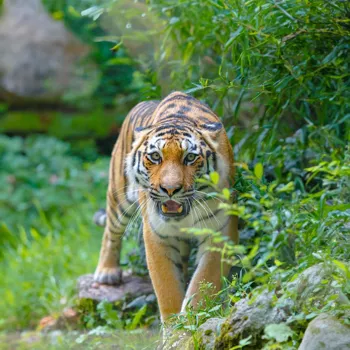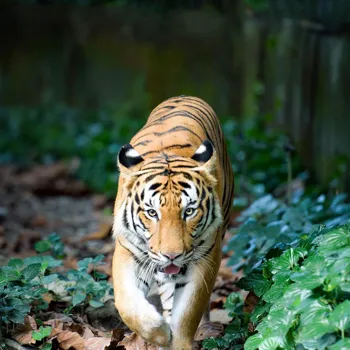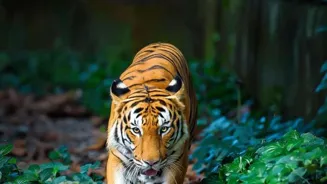Unraveling 10 Incredible Tiger Facts About India! Dive into the world of majestic tigers & their astonishing secrets
India, the land of vibrant colours, diverse cultures, and of course, the majestic Bengal
tiger! We all know about this striped beauty, our national animal, prowling through the jungles. But hold on, there's a lot more to these incredible creatures than meets the eye.

Get ready to be amazed as we uncover 10 astounding facts about India's tigers that you probably didn't know!
Tigers' roars: powerful communication tool in the jungle
Imagine being deep in the forest and hearing a sound that sends shivers down your spine. That could very well be a tiger's roar! These powerful vocalizations can travel up to 3 kilometers (almost 2 miles) away. Why so loud?

Tigers use their roars to communicate with each other, especially to mark their territory and attract potential mates. It's their way of saying, "This is my land, and I'm the boss!" Each tiger has a unique roar, just like our fingerprints.
This allows them to identify each other from a distance, which is pretty cool, isn't it? Imagine having a voice so powerful that it can be heard for miles! These roars also serve as a warning to other animals, letting them know to stay clear.
So, next time you hear about a tiger roaring, remember it's not just making noise; it's communicating in its own unique way. It is a majestic declaration of its presence in the jungle. The sound definitely adds a sense of both awe and respect for these beautiful animals.
Tigers' unique stripe patterns aid in camouflage and identification
Just like no two snowflakes are the same, no two tigers have identical stripe patterns. Their stripes are as unique as our fingerprints! These patterns are genetically determined, meaning a tiger inherits its stripe design from its parents.

These stripes aren't just for show; they serve a very important purpose: camouflage. They help the tiger blend in with the tall grasses and dense forests, making it harder for prey to spot them. It's like nature's own version of camouflage clothing!
Scientists also use stripe patterns to identify individual tigers in the wild, which helps them track tiger populations and study their behavior. So, the next time you see a tiger, remember that its stripes are not just beautiful, they are also a form of identification and a tool for survival.
The stripes help them stand out to us and blend in to the natural surroundings. It is amazing to see how such a vibrant creature is so much more.
Tigers are skilled swimmers, embracing water for cooling and hunting
Contrary to what you might think, tigers are not afraid of water! In fact, they are excellent swimmers and often use water to cool down on hot days. They can even swim across rivers to hunt or explore new territories. Unlike most cats who avoid water, tigers seem to enjoy it.

You might find them relaxing in pools or streams, especially during heat waves. This love for water is especially important in the hot and humid jungles of India. Tigers rely on water bodies not only for drinking but also for staying cool and hunting aquatic prey.
It's quite a sight to see a majestic tiger gracefully swimming through the water! This behaviour is proof that tigers are well adapted towards all forms of climate in India, making it an important part of their survival. As if they weren't impressive enough on land, they're also agile swimmers!
This amazing skill is quite different compared to other big cats, which is very unique.
Tigers are skilled nocturnal hunters with superior night vision
Tigers are primarily nocturnal, meaning they are most active at night. This is when they do most of their hunting. To aid them in their nighttime pursuits, tigers have incredibly well-developed night vision. They can see up to six times better than humans in the dark!
This allows them to easily spot prey in the low light conditions of the jungle. The combination of stealth, camouflage, and superior night vision makes them formidable hunters. They silently stalk their prey, using their senses of sight and hearing to pinpoint their location.
The jungle comes alive for tigers as the sun sets, which allows them a vantage point to hunt their prey. It's a classic example of how animals adapt to their environment to survive and flourish. Their success as predators depends on their ability to be active and see clearly in the darkness.
Tiger saliva has antiseptic properties aiding healing in wild
This one might sound a little strange, but it's true! Tiger saliva contains antiseptic properties. When a tiger gets injured, it licks its wounds to clean them and prevent infection. This natural antiseptic helps to keep the wound clean and aid in the healing process.

While this doesn't mean you should let a tiger lick your wounds, it's a fascinating example of the natural healing abilities found in the animal kingdom. It's like having a built-in first-aid kit! This is just one of the many ways tigers have adapted to survive in the wild.
They are well-equipped to handle the challenges of their environment, from hunting to healing. Mother Nature definitely knows what she's doing! This is proof that even in the wildest of beasts, there are natural remedies for all. It's just a small fraction of how intricate nature is.
Fact 6
Tiger Cubs Are Born Blind and Completely Dependent on Their Mother!
Tigress nurtures blind cubs, teaching survival in the wild
Tiger cubs are born blind and helpless. When a tigress gives birth, the well-being of her cubs is the top priority. She is their protector, provider, and teacher. They rely entirely on their mother for the first few weeks of their lives.

The tigress nurses them, keeps them warm, and protects them from danger. She also teaches them essential survival skills, such as hunting and stalking prey. It takes a lot of dedication and hard work to raise a litter of tiger cubs!
Watching a tigress care for her young is a beautiful example of the bond between mother and offspring. They slowly get introduced to the life of the forest and learn how to hunt and make food. It is an image of tender care.
It's also a reminder of the vulnerability of these amazing creatures, especially in the face of habitat loss and poaching.














